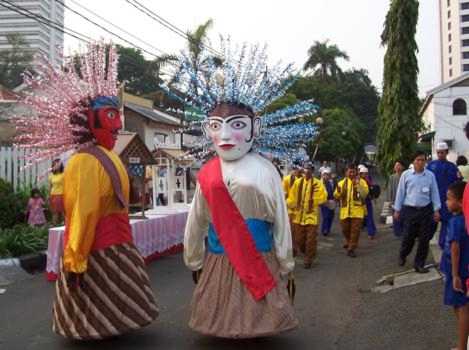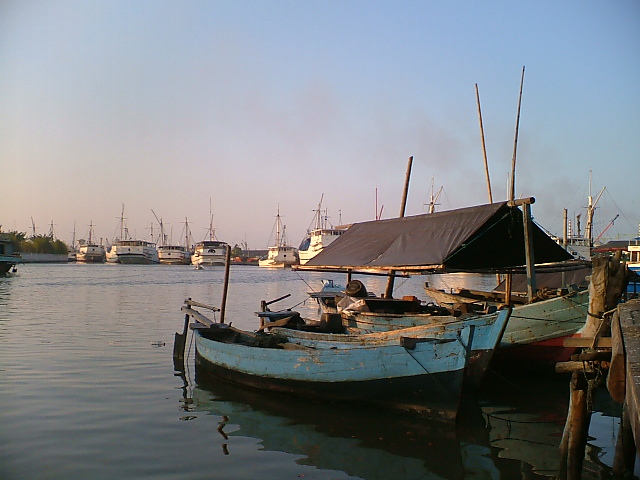
Jalan Jaksa Street in Jakarta is a place where you can feel the pulse of the city. It is a fascinating street located in Central Jakarta, Indonesia. The word ‘jalan’ means street in Indonesian and the name literally means Prosecutors' Street. There is an interesting piece of history that informs that Jalan Jaksa Street used to be a place where legal students flocked due to the fact that it featured affordable lodgings which suited their student budgets. The first hotel Wisma Delima opened in 1968 and is still there even today. Grim and shabby – these are perhaps the right terms to describe this stretch of road which is a sort of backpackers’ district. Unlike its other counterparts like Khao San road in Bangkok or Sosrowijayan in Yogyakarta where a kind of liveliness makes up for the shadiness, Jalan Jaksa Street in Jakarta has no qualms about its gray shades.
One of the main budget accommodation and budget entertainment streets in Jakarta, this not-too-long street is lined with countless hostels, hotels, travel agents, cafés, bars and restaurants. Tourists, specially, the first timers make it one of the most convenient locations for meeting as offers a selection of services helpful to the average tourist. With all standard backpackers’ needs available here, Jalan Jaksa Street attracts the bulk of backpackers and expat teachers of English in Jakarta. Come August and the Jalan Jaksa Street celebrates the Jaksa Street Festival with the traditional Betawi Folk arts, street parades and live music.

Accommodation in Jalan Jaksa Street in Jakarta
Jalan Jaksa Street and its surrounding areas offer a wide range of accommodation options. The street itself offers mainly low-end accommodation with hostels often situated off the main street on alley (gang) running out to the side. Wahid Hasyim Road which dissects the lower end of the street, has plenty of midrange options including the Ibis Hotel. For something a bit more decent, take a few minutes' cab ride to Thamrin Road where you can choose from several four and five star hotels.
Food in Jalan Jaksa Street in Jakarta
The sidewalks of Jalan Jaksa Street abound with countless make-shift eating places known as warungs. A gas burner, an old worked over cooking pan and a small grill fueled with coconut shells adorn the fast food stalls with grilled and fried food being cooked and ready in a few minutes. Fried rice or nasi goreng, fried noodles or mie goreng, satay or small beef kebabs with peanut sauce, grilled fish or ikan baker are the most popular ones. The street also features several cafes and restaurants where you can have the conventional western dishes.
Nightlife in Jalan Jaksa Street in Jakarta
Jalan Jaksa Street has several bars and cafés and what is most delightful about them is that here you can have your favorite beer at a price that costs a little more than it costs to buy from a local supermarket. Whereas, in most of the places in Jakarta, the price of alcoholic beverages can often be higher than in European capitals. Every roadside vendor here also seems to sell beer; ice-packed, beer-filled cool boxes are a common sight here. Some bars also play live music and offer other facilities like a pool table. A mixed crowd of prostitutes, shoddy middle-aged expats and Jakarta youngsters throng these places. However, the new age up-market style bars are coming up with fully air conditioned ambience featuring pool tables and projection screen televisions.
Shopping in Jalan Jaksa Street in Jakarta
Jalan Jaksa Street may be an odd choice for shopping in Jakarta but it can turn out to be a once-in-a-lifetime experience. Sarinah Mall is the handiest place for a last minute shopping. There are several floors selling clothes, souvenirs, batik and the third and fifth floor have two internet cafes. A medium sized supermarket can be found in the middle at the fork leading to jl Kebon Sirih Barat. Fast internet cafes are located on both sides of the supermarket. Travel agencies are on Jalan Jaksa offer worldwide package services.
How to Reach Jalan Jaksa Street in Jakarta
Jalan Jaksa Street is located at the heart of Jakarta close to the station, the National monument and the block M bus terminal. You can either walk from the station take a cab. Or, take one of the air-conditioned buses, get off at Sarinah Mall and walk from there.





![[ciliwung_s.jpg]](https://blogger.googleusercontent.com/img/b/R29vZ2xl/AVvXsEi1wa6RStoe7lyNBfQALpgC2qLEyaQ8xiIpHq6Ko2IZqy59AptZtwbl3S1EzoQMYlaZD-uD2NXbu7BVA82uudpwR9pcxuDvKs6G7LC58VAPYU37Im2MW2PIYOdke76QbWhEosbFNhjBQGsb/s1600/ciliwung_s.jpg)